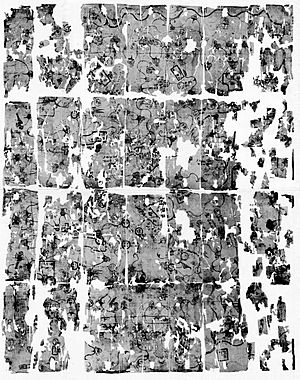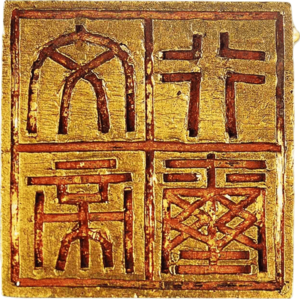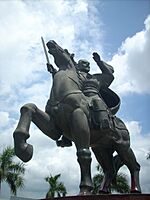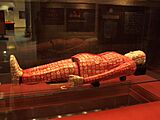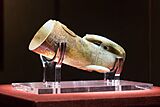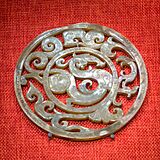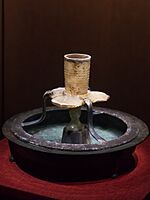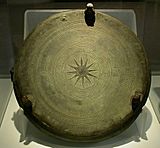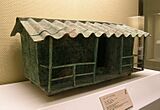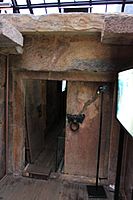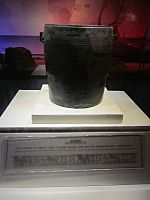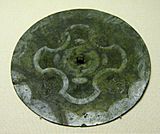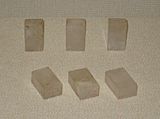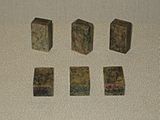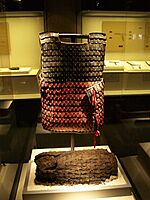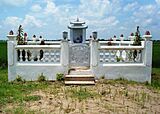Triệu dynasty facts for kids
Quick facts for kids
Nanyue
Nam Việt 南越國
Nam Việt Quốc Nanyueguo |
|||||||||||||
|---|---|---|---|---|---|---|---|---|---|---|---|---|---|
| 204 BC–111 BC | |||||||||||||
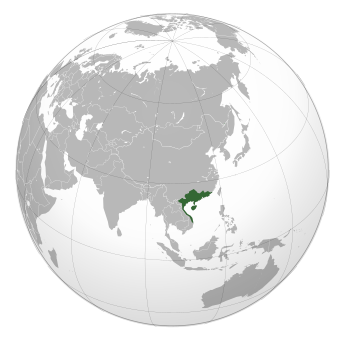
Location of Nanyue at its greatest extent
|
|||||||||||||
| Capital | Panyu | ||||||||||||
| Common languages | Old Yue language | ||||||||||||
| Religion | Vietnamese folk religion Chinese folk religion local Shamanism |
||||||||||||
| Demonym(s) | Triệu dynasty | ||||||||||||
| Government | Monarchy | ||||||||||||
| Emperor (Hoàng đế) | |||||||||||||
|
• 204–137 BC (first)
|
Zhao Tuo (Triệu Vũ Đế) |
||||||||||||
|
• 112–111 BC (last)
|
Zhao Jiande (Triệu Dương Vương) |
||||||||||||
| Military dictators (de factor) | |||||||||||||
|
• 130/124-111 BC
|
Lü Jia (Lữ Gia) | ||||||||||||
| History | |||||||||||||
|
• Qin-Baiyue war
|
221 BC | ||||||||||||
|
• Established
|
204 BC | ||||||||||||
|
• First tribute to Han dynasty
|
196 BC | ||||||||||||
|
• Zhao Tuo accession
|
183 BC | ||||||||||||
|
• Conquest of Âu Lạc
|
179 BC | ||||||||||||
|
• Second tribute to Han dynasty
|
179 BC | ||||||||||||
| 111 BC | |||||||||||||
|
• Disestablished
|
111 BC | ||||||||||||
| Population | |||||||||||||
|
• 111 BC estimate
|
1,302,805 | ||||||||||||
|
|||||||||||||
| Today part of | Vietnam China |
||||||||||||
| Triệu/Zhao |
|||
|---|---|---|---|
| Country: | Kingdom of Nam Việt | ||
| Titles: |
|
||
| Founder: | Triệu Đà | ||
| Final Ruler: | Triệu Kiến Đức | ||
| Founding Year: | 3th century | ||
The Triệu dynasty (also known as the Zhao dynasty) ruled the kingdom of Nanyue. This kingdom covered parts of southern China and northern Vietnam. Its capital city was Panyu, which is now Guangzhou.
The dynasty was started by Zhao Tuo (Triệu Đà). He was a Chinese general from Hebei province. He worked for the Qin dynasty as a military governor. When the Qin dynasty began to fall apart in 207 BC, Zhao Tuo declared Nanyue independent. The people who ruled Nanyue included both local Yue people and Chinese immigrants.
Zhao Tuo took over the Vietnamese state of Âu Lạc. He also led a group of Yue states in a war against the Han dynasty. The Han dynasty was trying to expand its control southward. Later rulers of Nanyue were not as strong. The Han dynasty finally conquered the kingdom in 111 BC.
Contents
How Historians See Nanyue
Historians from China and Vietnam have different ideas about the Triệu dynasty. Chinese historians often saw Nanyue as a separate group from the Han dynasty. But they also praised Nanyue for bringing Chinese culture to the region.
Vietnamese historians have debated whether to see the Triệu dynasty as heroes who founded Vietnam or as foreign invaders. For many centuries, Zhao Tuo was seen as a hero in Vietnam. People remembered him for standing up to the Han Empire.
For example, in the 13th century, a historian named Lê Văn Hưu wrote a history of Vietnam. He started his history with the Triệu dynasty. He praised Zhao Tuo as Vietnam's first emperor. However, later historians, like Ngô Thì Sĩ in the 18th century, saw Zhao Tuo as a foreign invader. Today, the Vietnamese government usually sees Zhao Tuo as a foreign invader.
History of Nanyue
Zhao Tuo, the Founder
Zhao Tuo (ruled 204–136 BC) was the first ruler of the Triệu dynasty. He was Chinese, born in the State of Zhao. In 208 BC, he became the military governor of Nanhai (modern Guangdong). This happened as the Qin dynasty was collapsing.
The Qin governor told Zhao Tuo to create his own kingdom. This was because the area was far away and had many Chinese settlers. In 204 BC, Zhao Tuo declared Nanhai independent. He called himself the King of Nam Việt. His kingdom covered areas like Guangdong, Guangxi, and parts of Hunan and Jiangxi.
Zhao Tuo ruled Nanyue and challenged the Emperor Gaozu of Han. He cut all ties with the Han dynasty. He even killed Han officials and supported the local customs of the Yue people. Zhao Tuo was a skilled general and a clever diplomat. He tried to keep peace with both the Qin and Han dynasties.
In 196 BC, the Han Emperor Gaozu sent a scholar named Lu Jia to meet Zhao Tuo. Zhao Tuo greeted him in the Yue style, squatting and with his hair in a bun. Lu Jia reminded Zhao Tuo that he was Chinese and should respect the Han emperor. After Lu Jia warned of a Han attack, Zhao Tuo apologized. They made an agreement for trade between Han and Nanyue. This made Emperor Gaozu happy.
Later, in 185 BC, the Han empress dowager Lü Zhi stopped trade with Nanyue. Zhao Tuo was angry. He said the empress was treating him like a barbarian. In response, Zhao Tuo declared himself an emperor. He attacked some border towns. Other Yue states recognized him as emperor. The Han army sent against Nanyue got sick with cholera.
In 180 BC, Zhao Tuo made peace with the Han Empire again. He agreed to recognize the Han ruler as the only emperor. This peace meant Nanyue lost its control over other Yue states. Zhao Tuo had built his army to fight the Han. Now, he used it to conquer the Âu Lạc kingdom in northern Vietnam. This happened in 179–180 BC.
Zhao Tuo divided his kingdom into two regions: Cửu Chân and Giao Chỉ. Giao Chỉ covered most of northern Vietnam. He allowed each region to have representatives in his government. This made his rule feel relaxed and spread out. But he still kept control. Zhao Tuo died in 136 BC. He had ruled for over 70 years and lived longer than his sons.
In Vietnam, Zhao Tuo is known from the "Legend of the Magic Crossbow." In this story, Zhao Tuo's son, Trong Thủy, married Mỵ Châu. She was the daughter of King An Dương of Âu Lạc. Trong Thủy used her love to steal the secret of An Dương's magic crossbow.
Zhao Mo, the Second Ruler
Zhao Tuo died in 136 BC. His grandson, Zhao Mo (Triệu Mạt), became the next ruler. He was 71 years old when he became king. In 135 BC, the Minyue people attacked Nanyue. Zhao Mo asked the Han Empire for help.
The Emperor Wu of Han offered to send his army. He said it was to help Nanyue, but he also hoped to take over the country. Zhao Mo's son, Crown Prince Zhao Yingqi, was sent to live and study in the Han court. Zhao Mo saw this as a friendly gesture from Emperor Wu. He thought it would make the relationship between Han and Nanyue stronger. Zhao Mo died in 124 BC. His tomb was found in Guangzhou in 1983.
Zhao Yingqi, the Third Ruler
Zhao Yingqi (Triệu Anh Tề) ruled from 124–112 BC. He was the crown prince when his father, Zhao Mo, died. Zhao Yingqi's becoming king was a way to show respect to the Han emperor. Zhao Yingqi had lived most of his life in the Han dynasty. He had a son named Zhao Xing with a Chinese woman named Lady Jiu. Some believe she was Emperor Wu's daughter.
Zhao Yingqi only got permission to go home for his father's funeral in 124 BC. Then he became the king of Nanyue. Not much is known about his rule. This is probably because it was short and he was very loyal to the Han emperor. When he died, his son, Zhao Xing, was only about 6 years old. Because Zhao Xing was so young, his mother, Lady Jiu, became the Empress Dowager. Zhao Yingqi's death led to the Han forces taking over Nanyue.
Zhao Xing, the Young King

Zhao Xing (Triệu Hưng) became king when he was just 6 years old (ruled 113–112 BC). Soon after, Emperor Wu of Han asked him and his mother, Lady Jiu, to visit the Han court. The Han dynasty kept Lady Jiu and Zhao Xing. They said it was to protect the young king. By agreeing to this, the empress dowager and the young emperor made people think they were controlled by the Han court.
With Zhao Xing in their hands, the Han dynasty prepared to invade. In 112 BC, the emperor sent two commanders, Lu Bode and Yang Pu, with 5,000 soldiers to invade Nanyue.
Zhao Jiande, the Last King
Nanyue's senior prime minister, Lü Jia, sent the army to meet the Han forces at the border. The Nanyue army was strong but smaller. Inside the country, people heard that Zhao Xing was held by the Han dynasty. They feared their king would be harmed if they fought back. The country was in chaos.
As the Han kept sending more soldiers, the Nanyue army could not hold their position. Lü Jia saw that Nanyue needed a new king to calm the people and inspire them to fight. Zhao Jiande (Triệu Kiến Đức) became the new king. He was Zhao Yingqi's oldest son from another wife. He took on the difficult task of leading his people to war.
End of the Dynasty
Emperor Wu of Han sent many soldiers against Nanyue. The young king was not experienced, and his army, though brave, was not well-trained. Nanyue could only hold out for a short time. The Han army defeated the Nanyue army. Lü Jia and King Zhao Jiande fought until the very end. Temples dedicated to Lü Jia and his soldiers in northern Vietnam suggest the war might have lasted until 98 BC.
After the capital city of Panyu fell, Tây Vu Vương, a local leader, rebelled against the Han. He was later killed by his assistant.
After the war, Nanyue's land was divided into nine districts. It became part of the Han dynasty as the area of Jiaozhi (Giao Chỉ). The Han dynasty ruled Jiaozhi until the revolt of the Trưng Sisters in AD 40.
List of Rulers
| Posthumous name | Given name | Reign | ||||
|---|---|---|---|---|---|---|
| Chinese | Pinyin | Vietnamese | Chinese | Pinyin | Vietnamese | |
| 武帝 | Wǔ Dì | Vũ Đế | 趙佗 | Zhào Tuó | Triệu Đà | 203–137 BC |
| 文帝 | Wén Dì | Văn Đế | 趙眜 | Zhào Mò | Triệu Mạt | 137–122 BC |
| 明王 | Míng Wáng | Minh Vương | 趙嬰齊 | Zhào Yīngqí | Triệu Anh Tề | 122–115 BC |
| 哀王 | Āi Wáng | Ai Vương | 趙興 | Zhào Xīng | Triệu Hưng | 115–112 BC |
| 術陽王 | Shù Yáng Wáng | Thuật Dương Vương | 趙建德 | Zhào Jiàndé | Triệu Kiến Đức | 112–111 BC |
Nanyue Culture
The cultures of the Han and Yue people mixed in important ways in Nanyue. This can be seen in the many artifacts found by archaeologists in the Nanyue tomb in Guangzhou. The tomb is very rich with items. Many bronze objects show influences from Han, Chu, Yue, and Ordos regions.
Images for kids
-
Statue of King Zhao Tuo (Triệu Đà)
See also
- An Dương Vương
- Âu Lạc
- Baiyue
- Changsha Kingdom
- Dong Son culture
- Emperor Wu of Han
- Han conquest of Nanyue
- Lü Jia (Nanyue)
- Minyue
- Museum of the Mausoleum of the Nanyue King
- Nanyue
- Panyu District
- Tây Vu Vương
- Yelang
- Zhao Tuo



